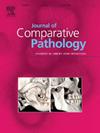Gross, cytological and histological features of a cholangiocarcinoma, with immunolabelling of cytokeratin 19, in a bronze-winged parrot (Pionus chalcopterus)
IF 0.8
4区 农林科学
Q4 PATHOLOGY
引用次数: 0
Abstract
An adult bronze-winged parrot (Pionus chalcopterus) was presented for post-mortem examination following death without antecedent clinical signs. Macroscopically, the liver was expanded by a 14 × 12 × 10 mm, off-white to grey, infiltrative mass with 3–8 mm diameter nodular masses on the serosa of the duodenum. Cytology of impression smears of the hepatic mass revealed a monomorphic population of epithelial cells, arranged in cohesive clusters, occasionally with an acinar-like arrangement. Histologically, the neoplasm was unencapsulated, infiltrative, well-demarcated and moderately densely cellular. Neoplastic cells were arranged in well-defined, variably sized acini and tubules that were supported by a fine collagenous stroma. Acini and tubules frequently contained intraluminal eosinophilic proteinaceous material. Neoplastic cells were small to moderately sized and were generally columnar or cuboidal with well-delineated cell boundaries and a small amount of eosinophilic to basophilic cytoplasm. The nuclei were round, frequently basally located and had densely stippled chromatin and usually a single, prominent, magenta nucleolus. There were two mitoses in 10 high-power fields (2.37 mm2). Vascular invasion was observed and metastatic nodules of similar neoplastic cells were present on the duodenal serosa. Immunohistochemical labelling for cytokeratin 19 revealed weak to moderate, punctate cytoplasmic expression in <10% of neoplastic cells. Macroscopically, cytologically and histologically the neoplasm was consistent with a cholangiocarcinoma.

铜翅鹦鹉胆管癌的大体、细胞学和组织学特征及细胞角蛋白19的免疫标记
一只成年铜翅鹦鹉(Pionus chalcopterus)在死亡前无任何临床症状的情况下进行了尸检。宏观上,肝脏扩张为14 × 12 × 10 mm,灰白色至灰色浸润性肿块,十二指肠浆膜上直径3-8 mm的结节状肿块。肝脏肿块的印迹涂片细胞学显示上皮细胞的单形态群,排列成内聚簇,偶尔有腺泡样排列。组织学上,肿瘤无包膜,浸润性,界限清楚,细胞密度中等。肿瘤细胞排列在定义明确、大小不一的腺泡和小管中,由细小的胶原基质支撑。腺泡和小管常含有腔内嗜酸性蛋白物质。肿瘤细胞小至中等大小,通常呈柱状或立方状,细胞边界清晰,胞质中有少量嗜酸性至嗜碱性。细胞核圆形,常位于基部,染色质密点,通常有一个突出的品红色核仁。10个高倍视场(2.37 mm2)有2个有丝分裂。在十二指肠浆膜上可见血管浸润和类似肿瘤细胞的转移结节。细胞角蛋白19的免疫组织化学标记显示,10%的肿瘤细胞中存在弱至中度、点状的细胞质表达。从宏观、细胞学和组织学上看,肿瘤符合胆管癌。
本文章由计算机程序翻译,如有差异,请以英文原文为准。
求助全文
约1分钟内获得全文
求助全文
来源期刊
CiteScore
1.60
自引率
0.00%
发文量
208
审稿时长
50 days
期刊介绍:
The Journal of Comparative Pathology is an International, English language, peer-reviewed journal which publishes full length articles, short papers and review articles of high scientific quality on all aspects of the pathology of the diseases of domesticated and other vertebrate animals.
Articles on human diseases are also included if they present features of special interest when viewed against the general background of vertebrate pathology.

 求助内容:
求助内容: 应助结果提醒方式:
应助结果提醒方式:


